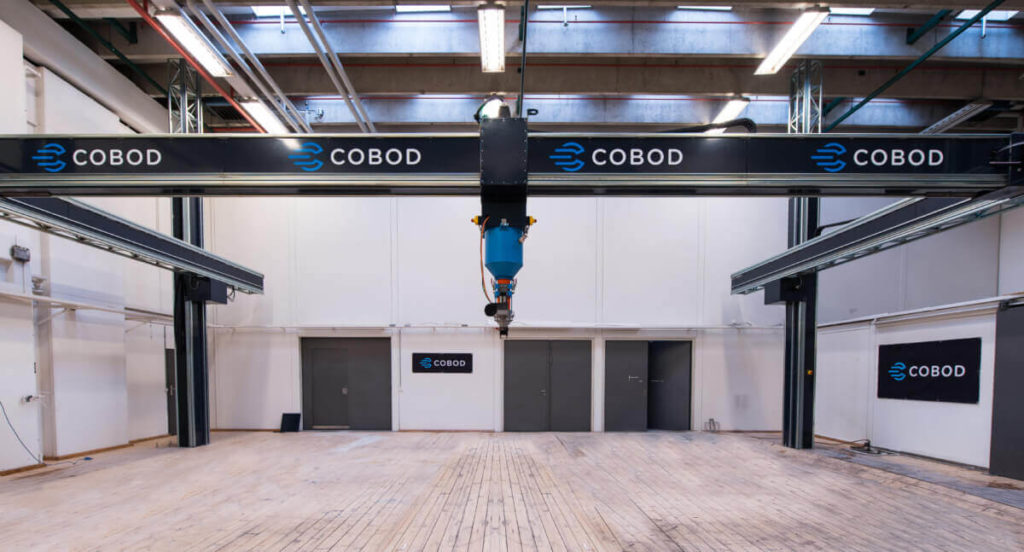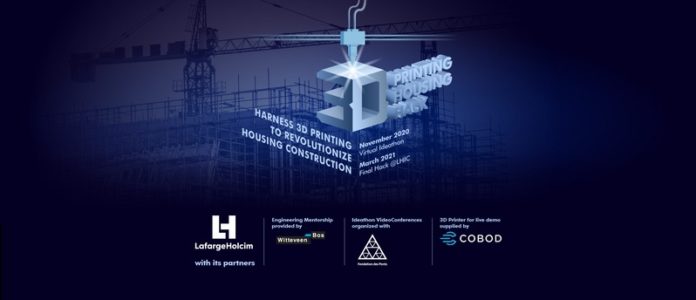Students who are interested in reinventing the building industry now have a destination to walk up to. Firms named Lafargeholcim has partnered with Witteveen+Bos, supported by COBOS, and Ecole des Ponts is calling on all such students who were waiting to bring into reality their out of box imaginations. This opportunity in the building industry is for students in the specific fields of engineering, architecture, and material science. A construction 3D printing hackathon is organized with the aim to receive new solutions, and leverage concrete 3D printing technology for making the construction industry capable of providing more effective and efficient housing than what it currently does.
A lot of research has been done about the people who lack adequate housing, as well as the contribution to CO2 emissions by the current building and construction sector. These researchers conclude one thing for sure i.e. there is a need for a revolution in the field of construction and this cannot be alone satisfied with any one particular sector of study and students. It requires an integrated effort from various fields that are interconnected and can jointly contribute towards providing housing solutions to the people who lack housing as well as effectively reconstruct sustainable housing for the people who are contributing to the global CO2 emissions.
Research states that 1.6 billion of the 7, lacks adequate housing. Additionally, those who have housing that is built by the past building and construction sector account for 40 percent of the global CO2 emissions. The field that offers a solution to both of these problems and can be a tool for addressing the challenges that are faced is none other than the trending manufacturing technology that has amazed the world by rethinking the opposite of subtractive manufacturing, i.e 3D printing from the additive manufacturing technology.
What 3D printing technology can do, that other technology can not?
This is a crucial question and its answer lies in doing the brainstorming of listing down the factors that are essential and common for building adequate housing, as well as decreasing the global CO2 emissions. If we think in this area we can come across the characteristics of 3D printing that match the solution factors.The first one into the list of those factors is: building more with less.

All those who have turned into using 3D printing technology from traditional manufacturing methods would agree to the fact that this new technology decreases the waste by a lot of extents! The raw material that we need for the subtractive manufacturing method is a lot more than what we need while building a part or functional prototype with the additive manufacturing method. And this is just by the mere shift in the perspective of the way in which manufacturing was looked then, compared to the way it is looked now. The pace of construction could be so fast, as it can be by using 3D printing technology. The building’s footprint can be reduced to a significant extent using this amazing technology.
The firm that is progressive in this way for developing greener building solutions is developing ways for deploying 3D printing for addressing the current day challenges that come into a way for building effective housing solutions. This firm is none other than LafargeHolcim. Find out more amazing buildings constructed using 3D printing on Pick 3D Printer.
According to LafargeHolcim and the research, not only can the important material but also resource savings can allow for a commendable reduction of the environmental footprint which will decrease the overall cost. Never before imagined speed like developing a house in just a few days can be achieved and that too with unmatched precision. And this is just the start; there is a lot more depth in which this technology can be dug up leading to solutions that can leverage new designs for leveraging new designs for optimizing:
- Use of the material in construction.
- Speed of the construction.
- Enhancing aesthetics.
- Customization potential of a residential building.
Experts take on this advancement
The concerned experts on this subject give their takes from various parts of the world. Obviously, this team of experts involves the research and development wing of LafargeHolcim, apart from him, there is also the Head of the Architecture Sustainable Design Pillar at Singapore University of Design and the concerned person for organizing this first unique hackathon from Witteveen+Bos.

Starting with Mr. Edelio Bermejo from the LafargeHolcim, who is convinced that,” 3D printing will be key in answering the challenges our industry is facing and that we need to join forces to make this groundbreaking technology a reality. Join us on this exciting adventure!”
His views are shared not only by experts and renowned academic faculties all over the world who are in connection with each other for discussing this issue. Professor Erwin Viray who is going to also share his views and vision via series of webinars and conferences says,” 3D printing redefines the built environment, shaping a naturally sustainable material with precision and real-time feedback for collaborating architects, engineers, and specialists. I wish everyone participating in the very best in discovering the homes of the future!” The professor is the head of the Architecture Sustainable Design Pillar at Singapore University of Design.
Arrangements for this Hackathon
The complete material that would be required for the students across the world will be provided by LafargeHolcim as a technical mentorship. Apart from this, the group is also going to offer a sum of EUR 15,000 as a total price pool and operational support to the winning team of this hackathon for completing their 3D project on a full scale.
Brief about LafargeHolcim

On the About Us section of the website of this company, it claims to be the leader in building global building materials and solutions by serving builders, architects, and engineers. Their operations produce cement, aggregates, and ready-mix concrete that are used for building projects that range anywhere from affordable housing and small, local projects to any bog project which is not only technically but also architecturally challenging infrastructures. A clear commitment to social as well as environmental sustainability is something that the company guarantees. The engineering mentorship is said to be provided by the company named Witteveen+Bos to all the participants of this hackathon. A digital construction consultant at this company, Marjin Bruurs says,” 3D printing has proven to have the potential to disrupt the construction industry, as we’ve already shown in several pilot projects around the world. However, to really change the industry over the next decade we need to further develop the technology and solutions. We need challenging ideas and we have to work together. That’s why we invite talent from across the world to participate in the hackathon!”
Brief about Witteveen+Bos

The company on its About us webpage claims to be a consulting and engineering firm that advises and help its clients all over the globe resolving current day’s complex challenges with its network of twenty-two offices in ten countries with some 1200 engineers and consultants working to improve the complete human environment for everyone, not only today but also for the future. They combine with stakeholders to contribute to social, ecological, and economic progress with sustainable development goals. The Areas of Expertise section on this website is divided into Built Environment, Deltas, coasts, and rivers, Energy, water and environment, and infrastructure and mobility. Fondation des Ponts is said to co-organize conferences whereas COBOD will provide a 3D printing robot for the live demonstrations.
Brief about COBOD

The company starts giving their introduction on the About Us webpage of their website by mentioning how they were able to build their first building in 2017 in Europe. BOD in their name stands for Building On Demand, based on the first project they were able to learn a lot of improvements made on their BOD printer. The company holds an award for winning the first-ever EU tender for the construction printers on the basis of BOD2. Since that year till date, the company has been going on to win one after the other rapid growth in this innovative field. Their printer BOD2 is able to print three-storeyed buildings more than 300 square meters on a single-storey. The company also boasts about having worked with Belgian Kamp C, German Peri Group, Danish Technical University, and Saudi Arabian Elite for Construction & Development. Additionally, the Peri Group also in 2019 began distributing the COBOD 3D construction printers in the German-speaking part of Europe.
The Conclusion
With these many huge names attached to this hackathon and seeing its aim to reduce global CO2 emissions as well as provide adequate housing for everyone, this event will manifest the significance of 3D printing technology which is still considered to be in its nascent stage. So, wait for the results which are definitely going to lead to innovations that this field has now been patiently waiting for years. Students all over the world who believe in changing the world by their imaginations are believed to participate in it for showing their vision and how it can positively impact the world.
